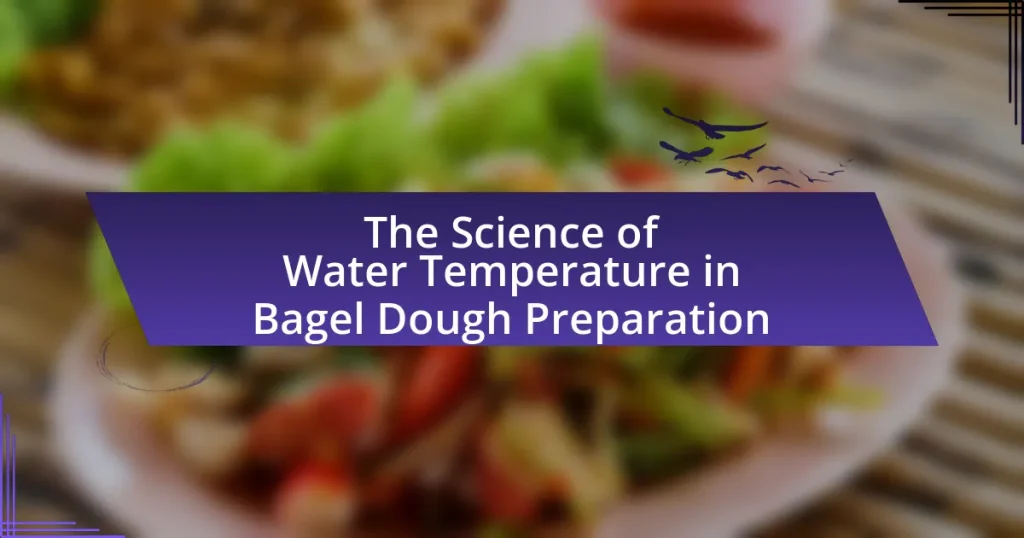The article focuses on mastering the perfect bagel boil, a critical step in bagel preparation that significantly influences texture and flavor. It details the boiling process, including optimal boiling times, water temperature, and the importance of ingredients such as malt syrup and baking soda. The article also explores the effects of boiling on bagel texture, crust development, and flavor enhancement, while providing practical tips and techniques for achieving consistent results. Additionally, it addresses common mistakes and troubleshooting methods to ensure the ideal bagel characteristics are achieved.

What is the Perfect Bagel Boil?
The perfect bagel boil is a crucial step in bagel preparation that involves boiling the dough in water, typically mixed with malt syrup or baking soda, to achieve the desired texture and flavor. This process gelatinizes the starches on the surface of the bagel, creating a chewy exterior while maintaining a soft interior. The ideal boiling time ranges from 30 seconds to 2 minutes per side, depending on the desired density and chewiness. This technique is supported by culinary experts who emphasize that the boil is essential for developing the characteristic crust and flavor of authentic bagels.
How does the boiling process affect bagel texture?
The boiling process significantly enhances bagel texture by creating a chewy crust and a dense interior. When bagels are boiled before baking, the high temperature gelatinizes the starches on the surface, forming a barrier that locks in moisture and contributes to the characteristic chewiness. This method also helps to develop a shiny, crisp exterior once baked, which is essential for the traditional bagel texture. Studies indicate that boiling for 30 seconds to 2 minutes optimizes these effects, ensuring the bagel achieves its desired density and chewiness.
What role does water temperature play in boiling bagels?
Water temperature is crucial in boiling bagels as it affects the cooking process and texture. Boiling bagels in water that is at a rolling boil (around 212°F or 100°C) ensures that the outer layer cooks quickly, creating a chewy crust while maintaining a soft interior. This rapid cooking process also helps to gelatinize the starches on the surface, which contributes to the bagel’s characteristic shine and texture. Studies have shown that the ideal boiling time and temperature can significantly influence the final product, with higher temperatures leading to a firmer crust and lower temperatures resulting in a softer bagel.
How long should bagels be boiled for optimal results?
Bagels should be boiled for 30 to 60 seconds on each side for optimal results. This boiling time is crucial as it helps develop the bagel’s characteristic chewy texture and shiny crust. Research indicates that boiling bagels for this duration allows the starches on the surface to gelatinize, which contributes to the final texture and flavor.
Why is boiling an essential step in bagel making?
Boiling is an essential step in bagel making because it creates the bagel’s characteristic chewy texture and shiny crust. The boiling process gelatinizes the starches on the surface of the dough, which helps to form a barrier that locks in moisture during baking. This results in a denser interior and a glossy exterior, distinguishing bagels from other types of bread. Additionally, boiling in water that may contain malt or baking soda can enhance flavor and color, further contributing to the bagel’s unique qualities.
What are the differences between boiled and unboiled bagels?
Boiled bagels are cooked in water before baking, resulting in a chewy texture and shiny crust, while unboiled bagels are baked directly without this step, leading to a denser and less glossy exterior. The boiling process gelatinizes the starches on the bagel’s surface, which contributes to the characteristic chewiness and enhances flavor through the Maillard reaction during baking. In contrast, unboiled bagels lack this pre-baking treatment, resulting in a different mouthfeel and appearance.
How does boiling contribute to the bagel’s crust?
Boiling contributes to the bagel’s crust by gelatinizing the starches on the surface, which creates a chewy and shiny exterior. This process occurs when the bagels are submerged in boiling water, typically with added ingredients like malt or baking soda, which enhance the crust’s texture and flavor. The high temperature of the water causes the outer layer of the dough to set quickly, forming a barrier that locks in moisture during baking, resulting in a distinctively dense and flavorful crust.

What Ingredients are Needed for the Perfect Bagel Boil?
The ingredients needed for the perfect bagel boil are water, malt syrup, and baking soda. Water serves as the primary medium for boiling, while malt syrup adds flavor and contributes to the bagel’s characteristic sheen. Baking soda increases the alkalinity of the water, which helps achieve a chewy texture. These ingredients are essential for creating the ideal environment for boiling bagels, ensuring they develop the right consistency and taste.
What type of water is best for boiling bagels?
The best type of water for boiling bagels is water that is heavily salted. Salting the water enhances the flavor of the bagels and contributes to a desirable crust texture. A common recommendation is to use about 1 to 2 tablespoons of salt per gallon of water. This practice is supported by traditional bagel-making techniques, which emphasize the importance of the boiling process in developing the bagel’s characteristic chewiness and shine.
How does the mineral content of water affect the boil?
The mineral content of water significantly affects the boiling process by influencing the temperature at which water boils and the texture of the bagels. Higher mineral concentrations, particularly calcium and magnesium, can raise the boiling point of water, leading to a more effective cooking environment for bagels. This is because minerals can create a more alkaline environment, which enhances the Maillard reaction, resulting in a better crust and chewiness. Studies have shown that water with a higher mineral content can improve the overall quality of boiled foods, including bagels, by promoting a desirable texture and flavor.
Should salt be added to the boiling water, and why?
Yes, salt should be added to the boiling water because it enhances the flavor of the bagels and contributes to their texture. When salt is dissolved in boiling water, it penetrates the bagels during the boiling process, resulting in a more flavorful final product. Additionally, the presence of salt in the water helps to create a firmer crust by affecting the gelatinization of starches in the bagel dough, leading to a desirable chewy texture. This technique is commonly used in traditional bagel recipes to achieve the authentic taste and texture associated with bagels.
What other ingredients can enhance the boiling process?
Adding ingredients such as baking soda, malt syrup, or honey can enhance the boiling process for bagels. Baking soda increases the alkalinity of the water, resulting in a chewier texture and a deeper color. Malt syrup contributes to flavor and browning due to its sugars, while honey can add a subtle sweetness and improve the bagel’s crust. These ingredients are commonly used in traditional bagel recipes to achieve the desired texture and appearance.
How do sweeteners like honey or malt syrup impact the bagel?
Sweeteners like honey or malt syrup enhance the flavor and color of bagels during the boiling process. When added to the boiling water, these sweeteners contribute to the Maillard reaction, which is responsible for the browning and development of complex flavors in the bagel crust. Additionally, honey and malt syrup can improve the bagel’s texture by creating a slightly chewy exterior while maintaining a soft interior. This effect is supported by culinary practices that emphasize the importance of sweeteners in achieving the desired bagel characteristics, as seen in traditional bagel recipes that incorporate malt syrup for optimal results.
What are the effects of adding baking soda to the boil?
Adding baking soda to the boil enhances the bagel’s texture and color. The alkaline nature of baking soda raises the pH of the water, which promotes the Maillard reaction during baking, resulting in a shiny, brown crust. Additionally, the increased alkalinity helps to create a chewier texture, characteristic of traditional bagels. This technique is supported by culinary science, which indicates that alkaline solutions improve browning and texture in baked goods.

What Techniques Can Improve Your Bagel Boiling Skills?
To improve your bagel boiling skills, use a combination of water temperature, baking soda, and boiling time. Boiling bagels in water that is at a rolling boil (around 212°F or 100°C) ensures they cook evenly and develop a proper crust. Adding baking soda to the boiling water increases the alkalinity, which enhances the bagel’s color and texture. A typical boiling time of 30 seconds to 1 minute per side allows for optimal surface development, creating that characteristic chewy exterior. These techniques are supported by culinary science, which indicates that the Maillard reaction, responsible for browning, is enhanced in alkaline conditions, resulting in a better bagel.
How can you ensure even boiling of bagels?
To ensure even boiling of bagels, maintain a consistent water temperature and avoid overcrowding the pot. A rolling boil at around 212°F (100°C) is essential, as this temperature helps the bagels cook uniformly. Additionally, boiling only a few bagels at a time allows for better water circulation, preventing them from sticking together and ensuring that each bagel receives equal exposure to the boiling water. This method is supported by culinary practices that emphasize the importance of temperature control and spacing in cooking techniques.
What methods can be used to prevent bagels from sticking together?
To prevent bagels from sticking together, applying a generous amount of flour or cornmeal to the surface where the bagels are placed is effective. This method creates a barrier that reduces moisture contact, which is a primary cause of sticking. Additionally, using a parchment paper lining on baking sheets can further minimize sticking, as it provides a non-stick surface. These techniques are commonly used in baking to ensure that the bagels maintain their shape and texture without adhering to one another.
How can you tell when bagels are ready to be removed from the boil?
Bagels are ready to be removed from the boil when they float to the surface and have been boiled for about 30 seconds to 1 minute on each side. This floating indicates that the bagels have developed a proper outer skin, which is essential for achieving the desired texture. The boiling process causes the starches on the surface to gelatinize, creating a barrier that helps the bagels maintain their shape during baking.
What common mistakes should be avoided during the bagel boil?
Common mistakes to avoid during the bagel boil include not using enough water, which can lead to uneven cooking, and failing to add baking soda or malt syrup to the boiling water, which enhances flavor and color. Additionally, overcrowding the pot can cause the water temperature to drop, resulting in poorly boiled bagels. It is also crucial to ensure that the bagels are boiled for the correct amount of time; under-boiling can lead to a dense texture, while over-boiling can make them too soft. These practices are essential for achieving the ideal bagel texture and flavor.
How can over-boiling affect the final product?
Over-boiling can negatively impact the final product by causing bagels to become overly soft and lose their characteristic chewy texture. When bagels are boiled for too long, the starches on the surface gelatinize excessively, leading to a mushy exterior instead of a firm crust. This alteration in texture can result in a less desirable eating experience, as the traditional bagel should have a balance of a chewy interior and a slightly crisp exterior. Additionally, over-boiling can dilute the flavor, as the prolonged exposure to water can wash away some of the essential flavors developed during the boiling process.
What are the signs of under-boiling in bagels?
The signs of under-boiling in bagels include a pale color, lack of sheen, and a dense texture. When bagels are under-boiled, they do not develop the characteristic golden-brown crust, which results from the Maillard reaction that occurs during proper boiling. Additionally, under-boiled bagels often have a chewy and gummy interior, indicating insufficient cooking time in the boiling water. Proper boiling typically enhances the bagel’s structure and flavor, so these signs are clear indicators that the boiling process was inadequate.
What are some practical tips for mastering the bagel boil?
To master the bagel boil, ensure you use a large pot filled with water and add a generous amount of malt syrup or baking soda to enhance flavor and color. The boiling water should reach a rolling boil before adding the bagels, which should be boiled for about 30 seconds on each side to achieve the desired chewy texture. Using a slotted spoon helps to remove the bagels easily without losing their shape. Additionally, preheating the oven to a high temperature, around 450°F, ensures a crisp crust after boiling. These techniques are supported by traditional bagel-making practices, which emphasize the importance of boiling in achieving the authentic bagel texture.
How can you troubleshoot common boiling issues?
To troubleshoot common boiling issues, first ensure that the water is at a rolling boil before adding bagels, as insufficient heat can lead to uneven cooking. If bagels are sticking to the pot, use a large enough pot and add a tablespoon of baking soda or malt syrup to the water to create a non-stick surface. If bagels are not achieving the desired color, increase the boiling time or adjust the water temperature. Additionally, if bagels are falling apart during boiling, check the dough’s hydration level and ensure proper kneading and resting times were followed, as these factors contribute to dough strength.
What best practices should you follow for consistent results?
To achieve consistent results in bagel boiling, maintain a precise water temperature of 212°F (100°C) and use a ratio of 1 tablespoon of baking soda per gallon of water. This practice ensures the bagels develop the desired chewy texture and shine. Research indicates that boiling bagels in water with baking soda enhances the Maillard reaction, resulting in a more flavorful crust. Additionally, boiling for 30 seconds on each side provides optimal cooking without compromising the bagel’s structure.



